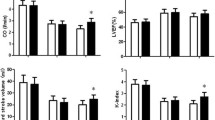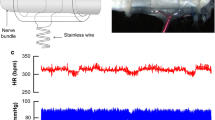Abstract
This study investigated whether vagal nerve stimulation (VNS) leads to improvements in ischemic heart failure via heart rate modulation. At 7 ± 1 days post left anterior descending artery (LAD) ligation, 63 rats with myocardial infarctions (MI) were implanted with ECG transmitters and VNS devices (MI + VNS, N = 44) or just ECG transmitters (MI, N = 17). VNS stimulation was active from 14 ± 1 days to 8 ± 1 weeks post MI. The average left ventricular (LV) end diastolic volumes at 8 ± 1 weeks were MI = 672.40 μl and MI + VNS = 519.35 μl, p = 0.03. The average heart weights, normalized to body weight (±std) at 14 ± 1 weeks were MI = 3.2 ± 0.6 g*kg−1 and MI + VNS = 2.9 ± 0.3 g*kg−1, p = 0.03. The degree of cardiac remodeling was correlated with the magnitude of acute VNS-evoked heart rate (HR) changes. Further research is required to determine if the acute heart rate response to VNS activation is useful as a heart failure biomarker or as a tool for VNS therapy characterization.





Similar content being viewed by others
References
De Ferrari, G. M. (2014). Vagal stimulation in heart failure. Journal of Cardiovascular Translational Research, 7, 310–320.
Zannad, F., De Ferrari, G. M., Tuinenburg, A. E., Wright, D., Brugada, J., Butter, C., Klein, H., Stolen, C., Meyer, S., Stein, K. M., Ramuzat, A., Schubert, B., Daum, D., Neuzil, P., Botman, C., Castel, M. A., D'Onofrio, A., Solomon, S. D., Wold, N., & Ruble, S. B. (2015). Chronic vagal stimulation for the treatment of low ejection fraction heart failure: results of the neural cardiac therapy for heart failure (nectar-hf) randomized controlled trial. European Heart Journal, 36, 425–433.
Hauptman, P. J., Schwartz, P. J., Gold, M. R., Borggrefe, M., Van Veldhuisen, D. J., Starling, R. C., & Mann, D. L. (2012). Rationale and study design of the increase of vagal tone in heart failure study: INOVATE-HF. American Heart Journal, 163, 954–962. e951.
Premchand, R. K., Sharma, K., Mittal, S., Monteiro, R., Dixit, S., Libbus, I., DiCarlo, L. A., Ardell, J. L., Rector, T. S., Amurthur, B., KenKnight, B. H., & Anand, I. S. (2014). Autonomic regulation therapy via left or right cervical vagus nerve stimulation in patients with chronic heart failure: results of the ANTHEM-HF trial. Journal of Cardiac Failure, 20, 808–816.
Hamann, J. J., Ruble, S. B., Stolen, C., Wang, M., Gupta, R. C., Rastogi, S., & Sabbah, H. N. (2013). Vagus nerve stimulation improves left ventricular function in a canine model of chronic heart failure. European Journal of Heart Failure, 15, 1319–1326.
Sabbah, H. N., Ilsar, I., Zaretsky, A., Rastogi, S., Wang, M., & Gupta, R. C. (2011). Vagus nerve stimulation in experimental heart failure. Heart Failure Reviews, 16, 171–178.
Li, M., Zheng, C., Sato, T., Kawada, T., Sugimachi, M., & Sunagawa, K. (2004). Vagal nerve stimulation markedly improves long-term survival after chronic heart failure in rats. Circulation, 109, 120–124.
Zheng, C., Li, M., Inagaki, M., Kawada, T., Sunagawa, K., & Sugimachi, M. (2005). Vagal stimulation markedly suppresses arrhythmias in conscious rats with chronic heart failure after myocardial infarction. Conf Proc IEEE Eng Med Biol Soc, 7, 7072–7075.
Li, M., Zheng, C., Inagaki, M., Kawada, T., Sunagawa, K., & Sugimachi, M. (2005). Chronic vagal stimulation decreased vasopressin secretion and sodium ingestion in heart failure rats after myocardial infarction. Conf Proc IEEE Eng Med Biol Soc., 4, 3962–3965.
Fox, K., Borer, J. S., Camm, A. J., Danchin, N., Ferrari, R., Lopez Sendon, J. L., Steg, P. G., Tardif, J. C., Tavazzi, L., & Tendera, M. (2007). Resting heart rate in cardiovascular disease. Journal of the American College of Cardiology, 50, 823–830.
Bohm, M., Swedberg, K., Komajda, M., Borer, J. S., Ford, I., Dubost-Brama, A., Lerebours, G., & Tavazzi, L. (2010). Heart rate as a risk factor in chronic heart failure (shift): the association between heart rate and outcomes in a randomised placebo-controlled trial. Lancet, 376, 886–894.
Bohm, M., Borer, J. S., Camm, J., Ford, I., Lloyd, S. M., Komajda, M., Tavazzi, L., Talajic, M., Lainscak, M., Reil, J. C., Ukena, C., & Swedberg, K. (2015). Twenty-four-hour heart rate lowering with ivabradine in chronic heart failure: insights from the SHIFT Holter substudy. European Journal of Heart Failure, 17, 518–526.
De Ferrari, G. M., Crijns, H. J., Borggrefe, M., Milasinovic, G., Smid, J., Zabel, M., Gavazzi, A., Sanzo, A., Dennert, R., Kuschyk, J., Raspopovic, S., Klein, H., Swedberg, K., & Schwartz, P. J. (2011). Chronic vagus nerve stimulation: a new and promising therapeutic approach for chronic heart failure. European Heart Journal, 32, 847–855.
Zhang, Y., Popovic, Z. B., Bibevski, S., Fakhry, I., Sica, D. A., Van Wagoner, D. R., & Mazgalev, T. N. (2009). Chronic vagus nerve stimulation improves autonomic control and attenuates systemic inflammation and heart failure progression in a canine high-rate pacing model. Circulation. Heart Failure, 2, 692–699.
Olshansky, B. (2015). Vagus nerve modulation of inflammation: cardiovascular implications. Trends in Cardiovascular Medicine.
Andersson, U., & Tracey, K. J. (2012). Neural reflexes in inflammation and immunity. Journal of Experimental Medicine, 209, 1057–1068.
Woodbury, D. M., & Woodbury, J. W. (1990). Effects of vagal stimulation on experimentally induced seizures in rats. Epilepsia, 31(Suppl 2), S7–S19.
Levy, M. N. (1971). Sympathetic-parasympathetic interactions in the heart. Circulation Research, 29, 437–445.
Sabbah, H. N., Imai, M., Zaretsky, A., Rastogi, S., Wang, M., Jiang, A., & Zaca, V. (2007). 509 therapy with vagus nerve electrical stimulation combined with beta-blockade improves left ventricular systolic function in dogs with heart failure beyond that seen with beta-blockade alone. European Journal of Heart Failure Supplements, 6, 114–114.
Barbato, E., Barton, P. J., Bartunek, J., Huber, S., Ibanez, B., Judge, D. P., Lara-Pezzi, E., Stolen, C. M., Taylor, A., & Hall, J. L. (2015). Review and updates in regenerative and personalized medicine, preclinical animal models, and clinical care in cardiovascular medicine. Journal of Cardiovascular Translational Research.
Krolczyk, G., Zurowski, D., Sobocki, J., Slowiaczek, M. P., Laskiewicz, J., Matyja, A., Zaraska, K., Zaraska, W., & Thor, P. J. (2001). Effects of continuous microchip (mc) vagal neuromodulation on gastrointestinal function in rats. Journal of Physiology and Pharmacology, 52, 705–715.
Val-Laillet, D., Aarts, E., Weber, B., Ferrari, M., Quaresima, V., Stoeckel, L. E., Alonso-Alonso, M., Audette, M., Malbert, C. H., & Stice, E. (2015). Neuroimaging and neuromodulation approaches to study eating behavior and prevent and treat eating disorders and obesity. Neuroimage Clin., 8, 1–31.
Shui, Z., Yamanushi, T. T., & Boyett, M. R. (2001). Evidence of involvement of GIRK1/GIRK4 in long-term desensitization of cardiac muscarinic K+ channels. American Journal of Physiology - Heart and Circulatory Physiology, 280, H2554–H2562.
Acknowledgments
We would like to recognize the staff of the Boston Scientific Research and Technology Center and in particular Jason Kilvington, Dennis Werner, Vijay Koya, Amy Townsend, and Holly Coleman for performing the surgeries and echocardiography procedures. We would like to acknowledge Dean Anderlie, Joshua Haarer, Dave Olson, Pete Kelley, and Jason Hamann for designing and manufacturing rodent VNS device. Finally, we would like to recognize Nicholas Wold, Jason Hamann, Stephen Hahn, Scott Meyer, and Juan Hincapie for their critical review of the study protocol and manuscript draft.
Author information
Authors and Affiliations
Corresponding author
Ethics declarations
All animal experiments were performed in accordance to the National Research Council Guide for the Care and Use of Laboratory Animals and approved by the Boston Scientific Institutional Animal Care and Use Committee.
Funding
This study was funded by Boston Scientific.
Conflict of Interest
Drs. Stolen and Ruble are employees of Boston Scientific, and Drs. Agarwal and Mokelke are former employees of Boston Scientific.
Human Subjects
No human studies were carried out by the authors for this article.
Additional information
Editor-in-Chief Jennifer L. Hall oversaw the review of this article
Electronic supplementary material
Below is the link to the electronic supplementary material.
ESM 1
(DOCX 21 kb)
Rights and permissions
About this article
Cite this article
Agarwal, R., Mokelke, E., Ruble, S.B. et al. Vagal Nerve Stimulation Evoked Heart Rate Changes and Protection from Cardiac Remodeling. J. of Cardiovasc. Trans. Res. 9, 67–76 (2016). https://doi.org/10.1007/s12265-015-9668-7
Received:
Accepted:
Published:
Issue Date:
DOI: https://doi.org/10.1007/s12265-015-9668-7




